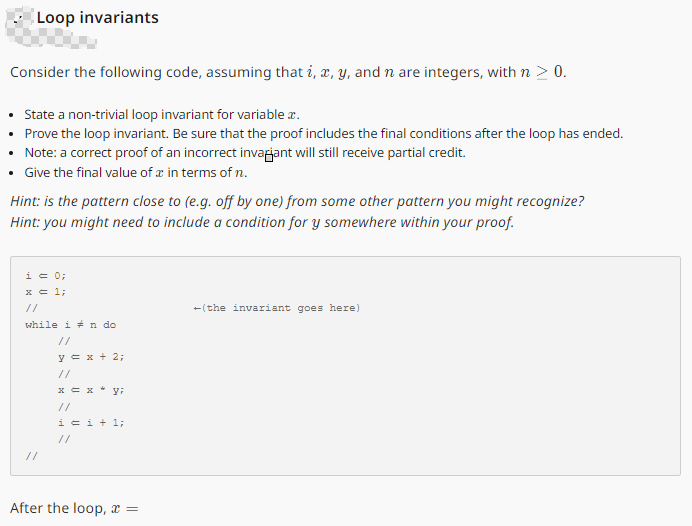Loop invariants 2000 Consider the following code, assuming that i, x, y, and n are integers, with n ≥ 0. • State a non-trivial loop invariant for variable . • Prove the loop invariant. Be sure that the proof includes the final conditions after the loop has ended. • Note: a correct proof of an incorrect invariant will still receive partial credit. • Give the final value of a in terms of n. Hint: is the pattern close to (e.g. off by one) from some other pattern you might recognize? Hint: you might need to include a condition for y somewhere within your proof.
Loop invariants 2000 Consider the following code, assuming that i, x, y, and n are integers, with n ≥ 0. • State a non-trivial loop invariant for variable . • Prove the loop invariant. Be sure that the proof includes the final conditions after the loop has ended. • Note: a correct proof of an incorrect invariant will still receive partial credit. • Give the final value of a in terms of n. Hint: is the pattern close to (e.g. off by one) from some other pattern you might recognize? Hint: you might need to include a condition for y somewhere within your proof.
Database System Concepts
7th Edition
ISBN:9780078022159
Author:Abraham Silberschatz Professor, Henry F. Korth, S. Sudarshan
Publisher:Abraham Silberschatz Professor, Henry F. Korth, S. Sudarshan
Chapter1: Introduction
Section: Chapter Questions
Problem 1PE
Related questions
Question
Help me fill the //

Transcribed Image Text:Loop invariants
Consider the following code, assuming that i, x, y, and n are integers, with n > 0.
• State a non-trivial loop invariant for variable x.
• Prove the loop invariant. Be sure that the proof includes the final conditions after the loop has ended.
Note: a correct proof of an incorrect invariant will still receive partial credit.
• Give the final value of a in terms of n.
Hint: is the pattern close to (e.g. off by one) from some other pattern you might recognize?
Hint: you might need to include a condition for y somewhere within your proof.
i = 0;
x = 1;
while in do
y = x + 2;
x=x*y;
i = 1 + 1;
After the loop, x =
(the invariant goes here)
Expert Solution
This question has been solved!
Explore an expertly crafted, step-by-step solution for a thorough understanding of key concepts.
This is a popular solution!
Trending now
This is a popular solution!
Step by step
Solved in 3 steps with 1 images

Knowledge Booster
Learn more about
Need a deep-dive on the concept behind this application? Look no further. Learn more about this topic, computer-science and related others by exploring similar questions and additional content below.Recommended textbooks for you

Database System Concepts
Computer Science
ISBN:
9780078022159
Author:
Abraham Silberschatz Professor, Henry F. Korth, S. Sudarshan
Publisher:
McGraw-Hill Education

Starting Out with Python (4th Edition)
Computer Science
ISBN:
9780134444321
Author:
Tony Gaddis
Publisher:
PEARSON

Digital Fundamentals (11th Edition)
Computer Science
ISBN:
9780132737968
Author:
Thomas L. Floyd
Publisher:
PEARSON

Database System Concepts
Computer Science
ISBN:
9780078022159
Author:
Abraham Silberschatz Professor, Henry F. Korth, S. Sudarshan
Publisher:
McGraw-Hill Education

Starting Out with Python (4th Edition)
Computer Science
ISBN:
9780134444321
Author:
Tony Gaddis
Publisher:
PEARSON

Digital Fundamentals (11th Edition)
Computer Science
ISBN:
9780132737968
Author:
Thomas L. Floyd
Publisher:
PEARSON

C How to Program (8th Edition)
Computer Science
ISBN:
9780133976892
Author:
Paul J. Deitel, Harvey Deitel
Publisher:
PEARSON

Database Systems: Design, Implementation, & Manag…
Computer Science
ISBN:
9781337627900
Author:
Carlos Coronel, Steven Morris
Publisher:
Cengage Learning

Programmable Logic Controllers
Computer Science
ISBN:
9780073373843
Author:
Frank D. Petruzella
Publisher:
McGraw-Hill Education